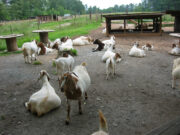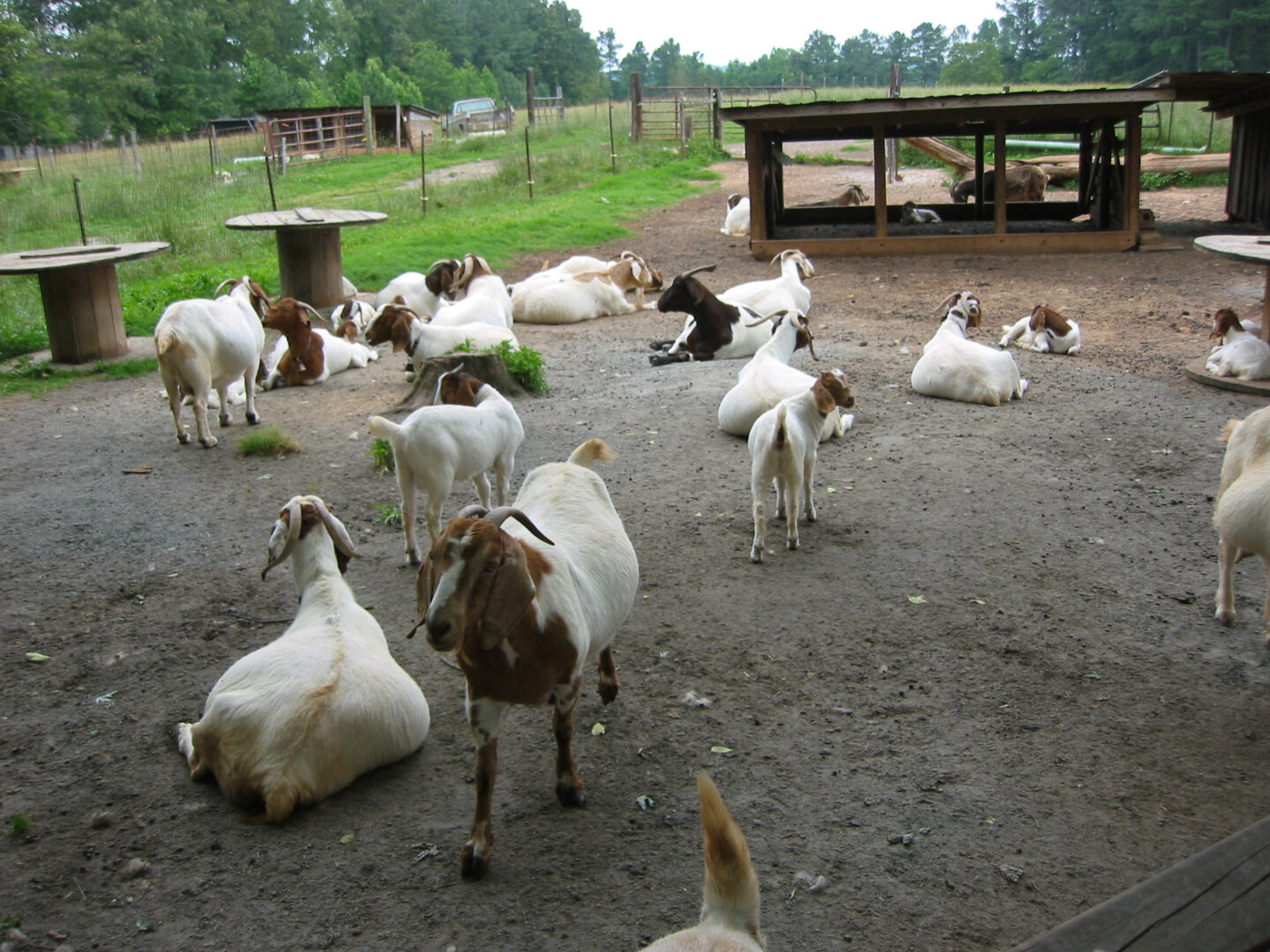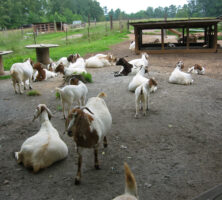Rural residents in Georgia have raised goats for many years. Goats provide food products and cash income and in some cases serve as pets. Goats are generally of three types: those that produce large quantities of milk, those that are raised for meat, and those kept for fiber (mohair and cashmere). In Georgia very few goats (Angoras) are kept for fiber production. Pygmy goats often serve as pets and show animals.
Dairy Goats
According to the 2017 U.S. Department of Agriculture (USDA) census there were approximately 8,949 goats kept on 809 farms in Georgia primarily for the production of milk. Georgia does not rank in the top ten states in total number of dairy goats; Wisconsin, California, Iowa, and Texas lead the nation. Most dairy goatherds in Georgia are located in the northern part of the state. The breeds most often used for milk production in Georgia include the Alpine, LaMancha, Nubian, Oberhasli, Saanen, and Toggenburg. In a commercial milk production system these breeds will yield an average of 1,800 to 2,400 pounds of milk per goat during the animal’s lactation period.
Some goat farms produce cheese as well as fluid milk. In most cases these products are for home use only because numerous regulations apply to the sale of food products to the public. State regulations governing the harvest, storage, and processing of goat milk are the same as those governing milk from dairy cows. Some goat owners make specialty products like goat-milk soap.
Dairy goats need specialized feed in order to ensure a long milk production period. Most goat kids are weaned from the mother at birth, after they have gotten the first milk, colostrum, which protects them from disease early in life. They are generally raised by hand using a bottle or pail. Good dairy goats will produce for six to ten months during any single lactation. Most in Georgia are milked by hand, but some dairies have milking machines.
Goats for Meat
Raising goats for meat is a rapidly growing agricultural enterprise in Georgia. Although common goats have been kept for meat for many years, since the mid-1990s there has been a rapid increase in the number of new enterprises for the commercial production of meat from goats. The 1997 USDA census estimated between 38,000 and 40,000 meat goats on about 1,790 farms in Georgia. This trend continued in the 2017 USDA census, with 59,232 meat goats on 3,277 farms.
Several factors have contributed to this growth. First, the number of people in Georgia who consume goat meat is expanding from year to year. Second, several new breeds have been introduced that have greater muscle mass and grow faster than the brush goats formerly seen in Georgia. Third, the merits of goat meat as a very lean product are becoming more widely recognized. Fourth, goats can fit well with other agriculture and farm enterprises, thus diversifying farm income—a risk management strategy.
Since about 1995 the Boer breed, developed in the Republic of South Africa, has transformed how people think about the production of meat from goats. Boer goats have a striking appearance with a dark red head and neck and a white body. The Kiko breed from New Zealand was introduced a couple of years later, and is also used in meat production. Most Kiko goats are white, but some are tan or even black in color. At about the same time, the “Spanish” goat in Texas was discovered by producers in Georgia, and several hundred were transported as a better alternative to the local brush or bush goat as a foundation for producing crossbred market animals.
Goats raised for meat can get along very well on native woody vegetation and brush, with little supplemental feed. It is important that they stay in the pasture, however, because many ornamental plants are poisonous to goats. The climate in Georgia is suitable for growing much of what goats prefer to eat.
Challenges
Because they are small, goats are subject to attack by predators—primarily neighborhood dogs and coyotes. Attacks are minimized by good fences, including electric wires, and by such guardian animals as dogs, donkeys, or llamas. Another major challenge in raising goats for meat is internal parasites (worms). These are especially bad when goats are kept in a relatively small area where they are continually exposed to larvae on low-growing pasture forage.
Most of the research conducted in Georgia on dairy and meat goats is carried out at the Georgia Small Ruminant Research and Extension Center on the campus of Fort Valley State University. Studies are conducted on reproductive physiology, cell biology, forage resources, feeds and nutrition, and novel methods for sustainable internal parasite control.






